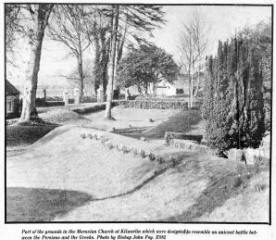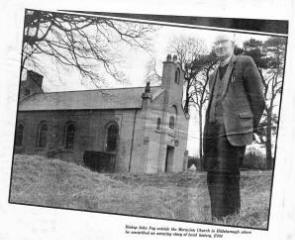
How the Moravian church came to Hillsborough!
Bishop John Foy chats 'to
'Star' reporter Stephanie Bell
about the history behind
the Moravian Church
The 'miracle' from Greece at kilwarlin
AT FIRST glance, the presence of a dusty old chest of drawers in the corner of the attic, did not strike Bishop John Foy as unusual.
It wasn't until many months later when he decided to examine the ancient piece of furniture more closely, that he unearthed a fascinating chapter of local history.
"I opened the drawers and a pile of old documents and manuscripts fell out. They must have been there since 1844," said Bishop Foy, "Together my wife and I sorted through them and pieced together the story of Zula."
The story of Zula has since captured the imagination of thousands of people. Bishop Foy has told it to interested audiences throughout Ireland, and on several occasions on television and radio.
The most recent person to show interest in Zula's unusual life was Sir Harry Secombe who interviewed Bishop Foy for his `Highway' programme which will be broadcast on U.T.V. on Sunday, March 6, "Sir Harry was very interested in Zula's story. He couldn't understand how a foreigner from Greece became a minister in the wilds of Ireland."
Bishop John Foy served most of his career as a Moravian Minister in England. In 1974 he retired with his wife to the manse at Kilwarlin in Hillsborough. It was here that he made his amazing discovery.
"Even today very few people have heard of the Moravian Church. It dates back to the 14th century when a group of people began to question the pope about the issuing of indulgences. They translated the bible into their own language and tried to base their lives on the teachings of the Sermon on the Mount. In 1457 they formed their own protestant church about 60 years before Luther.
At the start the church was badly persecuted.
Bishop Foy recalls the entire history of the Moravian church in such explicit detail that you would almost think he had experienced it for himself.
Dates and names covering a period of over four centuries are recalled up until the overseas mission finally arrived in Ireland in 1746 when John Cennick opened the first Moravian church here, in Dublin in 1747. He then brought his teachings to Ballymena where he met with a lot of opposition. The next two opened in Lisburn Borough at Lower Ballinderry and Kilwarlin in Hillsborough. Today there are also two churches in Belfast.
"The Kilwarlin church began in 1755. The congregation here never flourished for some time. In 1834 it was almost extinguished. The church Cennick had built was in ruins, the manse was uninhabitable and the grounds, a wilderness. The Marquis of Downshire who owned the land was threatening to take it away and it was at this time that the Greek miracle, as it has become known, happened."
The full story of Zula begins in the 1820s in his homeland of Greece during the war of independence against the Turks. "Bazil Patras Zula was just five years-old when his father died from wounds of war. His father had been the head of a clan and, at the age of eleven Zula was faced with the choice of either taking over the chieftainship or abdicating.
"He took it over and inevitably the Turks immediately put a price on his head. He was ambushed a couple of times and had to flee to Italy. When he returned to Greece the siege of Missolonghi took place and he was one of the few defenders who managed to break through the Turkish lines and escape, although he was wounded in the process.
"The Turks finally captured Missolonghi and killed everyone in it. This led to terrible atrocities from the Turks and the Greeks. Zula left, sickened by it and travelled to Smyrna in Asia Minor. It was here he met an English nobleman, Sir William Eden who became his travelling companion. Together they explored the River Nile and came to England and across to Dublin," recalls Bishop Foy.
It was in Dublin that Zula s life took an entirely different course and one which was to lead him to Hillsborough as the 'saviour' of the local Moravian church. "The two men booked into a hotel in Sackville Street called the Bilton Hotel. The proprietor was a religous man who held family prayers each morning at breakfast to which he invited the guests.
"On the morning Zula and his friend were there, Mr. Bilton was away and had invited a local school teacher and Moravian, Anne Linfoot to take the prayers in his place. As the curriculum in her school included Greek she was able to communicate with Zula and invited him to attend a service in the Moravian Church."
This led to Zula training to become a minister in the Moravian Church and on Easter Monday, 1829 he and Anne Linfoot married.
Bishop Foy quotes from Zula's personal diary about his feelings at this stage in his life. "He wrote in his dairy about Anne, `She was the instrument used by God to bring me to himself. I had nothing to offer her but myself which was accepted'."
It was in September 1834 that Zula and his wife came to Kilwarlin in Hillsborough. Finding it in its neglected and run-down condition, Zula immediately persuaded the Marquis not to take the lease away.
He then started to demolish the church and put up the present church building. When he finished, the church reopened in March 1835 when 25 new members attended the first service.
He rebuilt the manse and also built a small day school at the entrance to the grounds. It was in 1841 that Zula made his mark on Kilwarlin - one which attracts visitors far and wide today.
The Bishop explains, "His fear and hatred of the Turks was such that he couldn't go back to Greece. So in the grounds of the church he built his own memorial to his homeland. He recreated the Battle of Thermopylae which took place between the Greeks and Persians in 1480 B.C. when the Persians invaded Greece from the north.
"The Persians tried for days to pass through the Thermopylae pass to get to Athens. Eventually a Greek traitor showed the Perians the secret pass and they broke through and captured Athens.
Within a circular hollow formed by the Church driveway, this strange battlefield in a garden was constructed. "Six stone steps leading down into the hollow represent the eastern entrance to Thermopylae. Opposite them, near the entrance gates, is a grassy hillock, the Mount Aeta of the original battlefield. To the right of the Church driveway as seen from the Manse entrance is a small ornamental lake representing the Aegean Sea and from this lake an underground stream, representing the hot springs which gave Thermopylae its name, runs through the hollow.
"On the left is a grassy slope representing the foothills of the Callidromon range of mountains through which the pass of Thermopylae ran and beyond it a loftier mound which represents Mount Callidromos.
"Between the lower and loftier mounds is a norrow defile which represents the secret pass revealed to the Persians by a Greek traitor. In the middle of the hollow is a small ornamental pond around which were originally 24 flower beds each in the shape of a letter of the Greek alphabet. Only two remain - Alpha and Omega - marking the beginning and the ending of the original circle of 24.
"No doubt the Moravian Church in Hillsborough would not be there today if Zula had not arrived and saved it from total ruin," said Bishop Foy.
Among the valuable books and manuscripts found by the Foys in the Kilwarlin Manse were Zula's diary and many other handwritten documents including his wife's household accounts.
Bishop Foy has produced a leaflet recalling the history of the Moravian Church in Kilwarlin so that everyone is aware of Zula's story. He is a keen photographer and writer and is always happy - and proud - to share the story of `The Greek Miracle' at Kilwarlin.
He is still very closely involved with the church and on two occasions came out of retirement to stand in as minister at Kilwarlin.
Vital renovation work was recently carried out to the roof and church hall. A renovation committee was set up to raise funds to pay for the work. A Flower Festival is being held at the Church from April 8 until April 10 in aid of the fund.
The festival will also feature an exhibition and sale of work by local artists. It will be officially opened by Mrs. K. Grubb of the BBC gardening programme at 12 noon on Friday, April 8.
On Saturday the festival will open from 10 am until 8 pm and on Sunday from 11 am until 5 pm. It is hoped that the local public will go along and support the event.
Ulster Star date unknown circa 1970's


